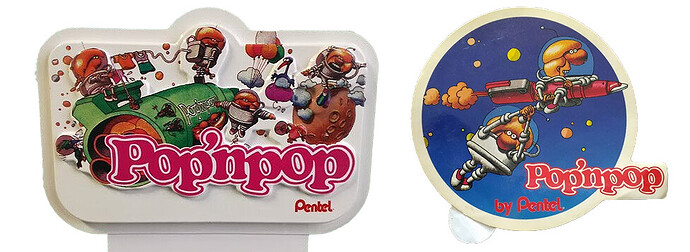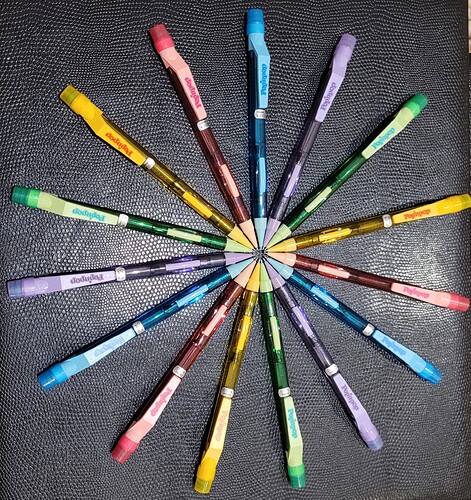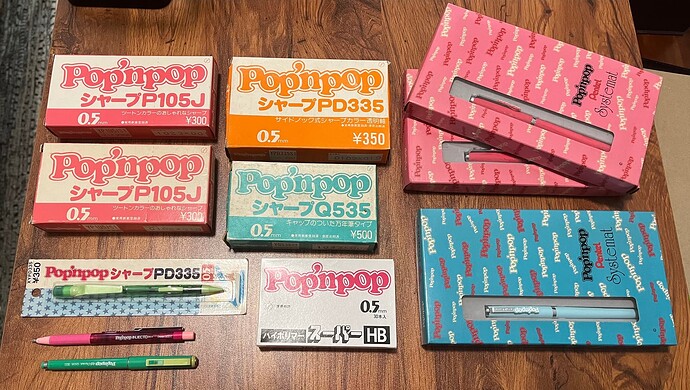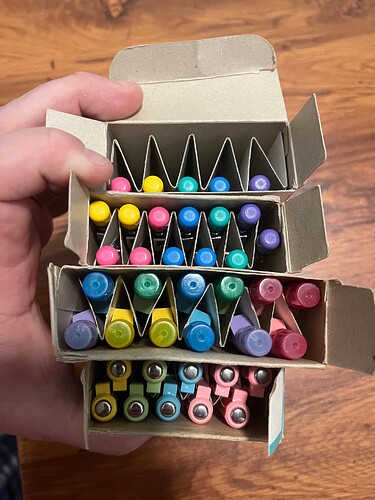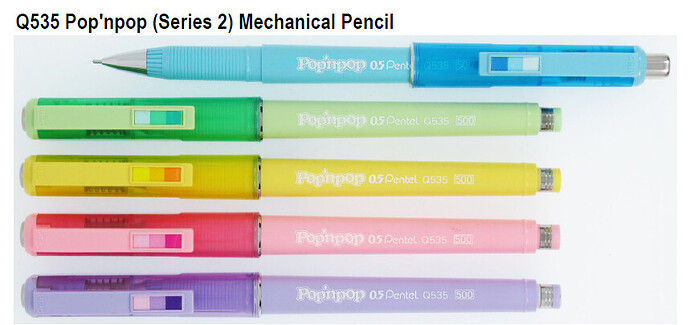The Story Behind Pentel’s Pop’npop Lineup
In the neon-colored swirl of 1980s Japan, Pentel’s Pop’npop series of writing instruments emerged as a playful icon of the era. These weren’t just writing tools – they were fashion statements and collectibles, arriving in eye-popping colors with a catchy name that still sparks curiosity decades later. To understand Pop’npop, we need to dive into the time and place of its birth: the exuberant 1980s bubble-era Japan, when youth culture and “fancy” stationery boomed, and English-sounding names were all the rage. Below, we explore the origins of the Pop’npop branding, its cultural meaning, and its lasting legacy.
Origins in the 1980s: Release and Discontinuation
Pentel introduced the Pop’npop lineup in Japan during the early-to-mid 1980s – the Showa era twilight years. The Pop’npop line seems to have launched in the first half of the 1980s and ran its course by the decade’s end, vanishing as the 1990s (and the end of Japan’s economic bubble) brought new trends. By now, it is classified as haiban (discontinued) and considered a nostalgic collectible of its time.
Determining the exact release year is tricky, but an initial Pop’npop series likely appeared around 1983-1984, with later iterations in the late ’80s featuring updated colors and designs. The lineup included mechanical pencils, ballpoint pens, and other fun stationery items. For example, Pentel’s Q535 Pop’npop mechanical pencil (a capped “pocket” model) went through two series in the 1980s – an earlier set in solid bright primaries (red, blue, green, yellow), and a later “Series 2” in more translucent pastel tones like blue, green, yellow, pink, and violet. This evolution from bold basics to transparent pastels aligns with mid-’80s trends, suggesting the Pop’npop lineup was refreshed at least once before being phased out. By the early 1990s, as Japan’s economy cooled and tastes changed, Pentel quietly retired the Pop’npop range. These writing instruments became fond memories in desk drawers and now occasionally resurface on secondhand markets as Showa retro treasures.
The Trend of English in Japanese Product Names
During the 1980s, Japan saw a surge in the use of English words in product branding, especially in industries like fashion, music, and stationery. This wasn’t necessarily about making products accessible to English speakers—it was about creating a cool, modern, and international feel. Words that sounded catchy or stylish were often borrowed from English, even if their meaning wasn’t entirely logical.
Pop’npop is a great example of this decorative English trend. The repetition of "Pop" adds an energetic, playful rhythm to the name, even though it doesn't have a literal meaning in Japanese. This naming style was common across various consumer goods at the time, as brands sought to appeal to younger generations who were drawn to Western pop culture.
Japanese marketers often chose English phrases that sounded fresh and lively, regardless of grammar or sense. This can be seen in everything from snack foods to fashion brands and even music genres like "City Pop." The goal was not linguistic accuracy but creating an aspirational or fun identity—which fits perfectly with the Pop’npop lineup’s colorful, youthful appeal.
What’s in a Name? The “Pop” Factor
The name Pop’npop is more than just catchy branding—it carries a sense of energy and excitement, much like the onomatopoeia “pop” itself. The word "pop" suggests something lively and dynamic, making it an ideal fit for a vibrant lineup of writing instruments.
Beyond its bright colors, the physical interaction with Pop’npop products may have played into the name’s appeal. Many of the mechanical pencils and pens in the series featured mechanisms that involved a popping action—whether it was clicking the top to advance lead, pressing a side button to extend a tip, or even removing a cap with a slight “pop” sound. The Q535 Pop’npop pencil, for instance, was a capped pocket model where users had to pop off the cap before writing, reinforcing the name’s playful, sound-like quality.
The repetition of “Pop” in the name further amplifies this sense of movement, making it feel almost rhythmic—like a double pop, suggesting continuous fun. Whether intentional or not, the name evokes both the excitement of using these tools and the physical sensation of engaging with them.
The Mystery of "Pop’npop"
Among collectors, one of the great unsolved mysteries is what Pop’npop actually means. Despite many theories—from it being an onomatopoeia to it representing a "pop" of color—there’s no definitive explanation from Pentel. The reality is that we may have assigned more meaning to the name than was originally intended. Like many Japanese products of the 1980s, it was likely just a trendy, fun-sounding name designed to catch attention.
Interestingly, there was a Japanese video game called Pop’npop, developed by Taito in 1998. However, there doesn’t appear to be any real connection between the game and Pentel’s stationery lineup. The shared name is probably a coincidence, another example of how the phrase "Pop’npop" was catchy enough to be used in different contexts.
Echoes of Pop’npop in the U.S.
While Pop’npop was mostly exclusive to Japan, similar trends emerged in the United States in the late 1980s and early 1990s. The vibrant, youth-oriented stationery trend was reflected in products like Lisa Frank’s neon-colored school supplies, which became wildly popular among American children. With bold colors, playful themes, and collectible appeal, Lisa Frank’s stationery followed the same “stationery as self-expression” philosophy that had made Pop’npop a success in Japan.
Other brands, such as Sanrio’s Hello Kitty and Trapper Keepers, also embraced bold, colorful, and highly stylized designs that turned everyday school supplies into fashion accessories. These brands, like Pop’npop, understood that stationery could be a statement piece rather than just a utility, blending functionality with personal identity.
Although the brands were distinct, the underlying cultural shift was similar—both Japanese and American children in the late 20th century sought customized, fun, and stylish school supplies that reflected their personalities. Pop’npop may not have fully reached U.S. shores, but its aesthetic and marketing approach foreshadowed trends that would later dominate American school culture.
Pop’npop’s Legacy: From Retro Collectible to Modern “Pop” Revival
Though the Pop’npop series was discontinued by the 1990s, its spirit lives on in several ways. Pentel’s contemporary catalog features a “Pop series” of pens and pencils, including gel pens named Sparkle Pop, Milky Pop, Solar Pop, and a colorful mechanical pencil set called Quick Click Pop.
Looking Back on a Stationery Icon
The Pop’npop lineup may have started as a fun, trendy product line in 1980s Japan, but its impact continues to be felt today. It represents an era when stationery wasn’t just about function—it was about self-expression, color, and fun.
For those who grew up using these pens and pencils, they are more than just collectibles—they’re reminders of a time when even the smallest items could bring joy. The legacy of Pop’npop proves that sometimes, the most memorable products are the ones that simply made everyday life a little more exciting.
